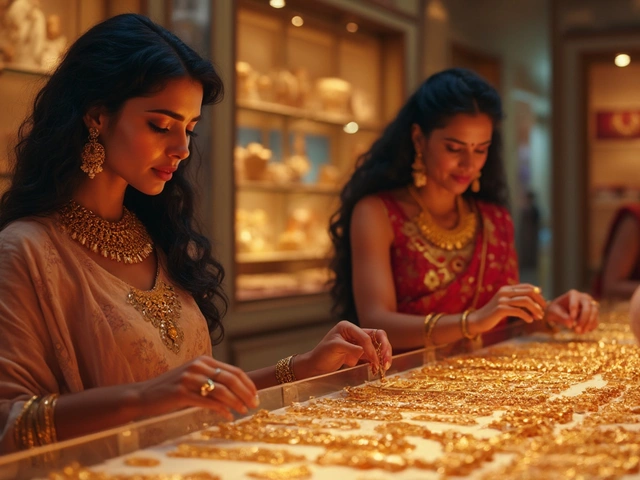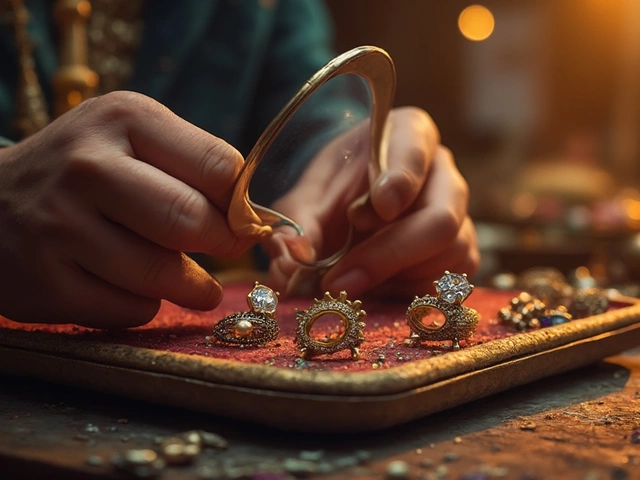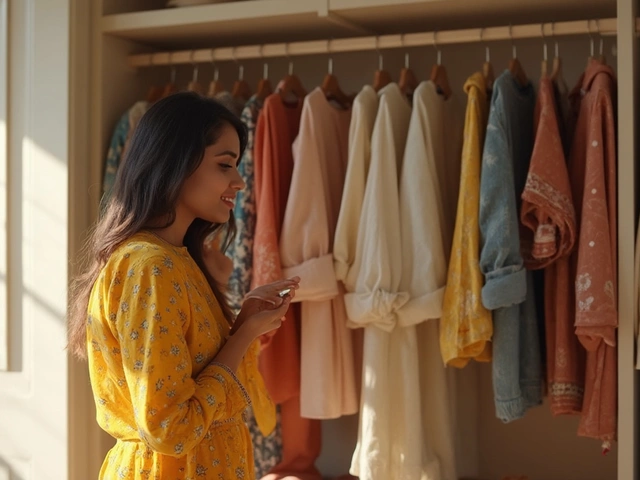
Ever stared at a box of old jewelry and wondered if you’re sitting on a goldmine or just a pile of shiny nostalgia? You’re not alone. Figuring out what your old jewelry is really worth isn’t magic or guesswork—it’s about checking the right things and not getting distracted by the glitter.
First, get curious about what’s actually in your hands. Is that ring solid gold, or just gold-plated? Real gold is always heavier than it looks. Check for official marks stamped inside the band—like 14K, 18K, or even “PLAT” for platinum. If a piece feels surprisingly light, it might just be thin metal or hollow. Don’t rush to start polishing: cleaning old jewelry the wrong way can erase history and kill its value in seconds.
- Spotting Valuable Materials
- The Importance of Age and History
- Understanding Maker’s Marks and Hallmarks
- When to Call in an Expert
Spotting Valuable Materials
All old jewelry isn’t created equal. Some pieces only look expensive, while others actually pack real value. Let’s break down how to separate the fakes from the finds.
First, zero in on the metal. Gold, silver, and platinum always lead the pack for value. Gold isn’t just “gold colored”—check for stamps like 10K, 14K, 18K, or even 24K tucked in a hidden spot on the band or clasp. For silver, look for marks like “925” or “Sterling.” Old platinum pieces usually have “PLAT” or “950” stamped somewhere.
It’s not just about the mark, though. If you’re dealing with something that feels too light or the plating’s rubbing off, chances are it’s costume jewelry and not the real deal. Valuable metals are usually heavier and won’t peel or chip from wear.
When it comes to stones, not everything that sparkles is a diamond. Glass, zircon, and other lookalikes have been fooling people for decades. An easy check: fog up the stone with your breath. Genuine diamonds clear up quickly, while fakes hang onto the mist.
Pearls and enamel can get tricky. Real pearls feel gritty on your teeth; fakes are smooth. High-quality enamel from past decades often means more value, especially if there’s no sign of chipping.
Here’s a quick rundown on common materials and how to spot them:
- Gold: Look for karat stamps and feel for weight.
- Silver: “Sterling” or “925” marks are your friend.
- Platinum: Heavy, bright white, marked “PLAT” or “950.”
- Diamonds: Clear up steam fast, sharp sparkle under light.
- Pearls: Gritty = real, slick = fake.
Here’s a table showing how these materials stack up in terms of average price per gram in 2024:
| Material | Average Price Per Gram (USD) |
|---|---|
| Gold (14K) | $38 |
| Platinum | $36 |
| Silver | $0.80 |
| Natural Diamond | $1600 (per carat) |
| Pearl (Akoya) | $8 (per gram) |
If you’re trying to figure out antique jewelry value, always start by checking the real materials. It’s the single biggest factor behind those surprise windfalls and the number one reason people drag jewelry into pawn shops hoping for a payday. Getting familiar with the simple marks and tests above helps you separate the treasure from the trinkets.
The Importance of Age and History
Most folks think if jewelry looks old, it's got to be worth a lot. Not always. What truly bumps up the value is how old it actually is and where it came from. A brooch from the 1800s made during Queen Victoria’s reign, for example, commands more attention—and often more cash—than something from the 1980s, even if the materials are similar.
Age gets tricky because some pieces were made to look older. Knowing your stuff here means looking at details in how the jewelry was made. Mass-produced jewelry didn’t really take off until after World War II, so if you spot rough, hand-cut stones or tiny irregularities, that hints at a pre-1940s piece. And if the item comes with paperwork, like an original box or receipt, this adds real value because it proves authenticity and history.
History matters just as much. Did someone famous own it? Was it custom-designed by a known jeweler? Provenance, which means the story or records of who owned the item, can send prices through the roof. Here’s a cool nugget: when Princess Diana’s sapphire engagement ring design started to resurface after Kate Middleton wore it, similar vintage jewelry saw prices shoot up nearly 20% in auction houses in just two years.
| Era | Years | Common Features |
|---|---|---|
| Victorian | 1837–1901 | Romantic symbols, yellow gold, lockets |
| Art Deco | 1920–1935 | Geometric designs, platinum, diamonds |
| Mid-Century | 1945–1970 | Bold shapes, mixed metals, textured finishes |
| Vintage | 1970–1990 | Chunky styles, synthetic stones, mass-produced |
If you’re after the real scoop on antique jewelry value, always dig into when and where a piece was made and who might have owned it. Old jewelry isn’t just old—it’s a slice of someone’s life, and that’s often what buyers pay for.

Understanding Maker’s Marks and Hallmarks
If you want to know what makes a piece of old jewelry valuable, you can’t skip the tiny stamps and symbols punched into the metal. These are the so-called maker’s marks and hallmarks. Think of them as a jewelry version of a birth certificate—full of clues about where it was made, what it’s made from, and sometimes even how old it is.
Maker’s marks usually point to who made the piece, whether it’s a big brand like Tiffany & Co. or a small-time artisan. Hallmarks, on the other hand, are there to show the metal’s purity, like “925” for sterling silver or “18K” for gold. In the UK, hallmarks have been law since the 1300s, but in the US, they became more common in the late 1800s.
Here’s what you want to look for:
- Antique jewelry value can swing a lot depending on rare maker marks. Signed pieces from famous makers are worth way more.
- Marks like “PLAT” or “950” mean platinum; “750” means 18K gold; and “585” means 14K. “925” is top-notch sterling silver. Fake or modern pieces might look similar but won’t have these marks.
- Some marks show the city or country where the piece was made. For example, a “lion passant” stamp on British silver proves it’s real sterling.
Not all marks are easy to spot. Sometimes they’re rubbed off with age or hidden in weird spots. Grab a magnifying glass and check clasps, insides of rings, or back sides of lockets.
Want a fast way to decode these mysteries? Here’s a basic guide:
| Mark | What It Means | Common Use |
|---|---|---|
| 925 | Sterling Silver | Necklaces, rings, brooches (since 19th century) |
| 750 | 18K Gold | High-end vintage and antique gold jewelry |
| PLAT / 950 | Platinum | Engagement rings, luxury pieces (20th century up) |
| Lion Passant | Sterling Silver (UK) | All types of British silver jewelry |
| Maker’s Initials/Logo | Who Made It | Designer, artisan, and branded pieces |
If you spot a mark you can’t identify, check resources like the Online Encyclopedia of Silver Marks or trade forums. The right hallmark can turn a $50 trinket into a $5,000 collectible—seriously.
When to Call in an Expert
Trying to figure out the real value of old jewelry can get tricky fast. Sure, you can google a few marks or test the weight, but some stuff is just out of your league if you’re not trained. Some antique jewelry pieces are rare, with histories that really matter. If you spot marks you don’t recognize, stones that seem odd, or weird construction, it’s a sign to get help from someone who knows their stuff.
Most people call a pro when:
- The piece is made by a well-known designer (like Cartier or Tiffany & Co.).
- You see engravings you can’t interpret, especially hallmarks from other countries.
- There’s damage or heavy wear, but the piece looks unique or very old.
- The jewelry might have gemstones you can’t identify by eye (like old mine-cut diamonds or rare colored stones).
Here’s something you might not realize: some jewelry from the Art Deco period (1920s–1930s) now sells at auction for up to $50,000 or more, even if it’s not made of solid gold. Age, design, and maker can matter just as much as materials.
If you’re seriously thinking about selling, or if your insurance company is asking for proof of value, a written appraisal from a certified gemologist is key. Only someone with credentials—like a Graduate Gemologist from GIA (Gemological Institute of America)—can give you reliable documents. That matters for sales, insurance claims, or even settling family estates.
| Situation | What an Expert Does |
|---|---|
| Unknown marks or signatures | Identifies the maker, verifies authenticity |
| Rare or old gemstone cuts | Identifies the type and age, estimates worth |
| Valuable designer items | Confirms provenance, increases value with paperwork |
| Insurance/estate planning | Issues formal appraisals accepted by insurers |
So, if you ever feel stumped or realize the piece could be more than just decorative, get a pro to check it out. Yes, you’ll pay a little for the service, but for antique jewelry value, it can mean the difference between letting go of treasure for peanuts and knowing its real story (and price!).








Write a comment